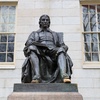"Scientists in general are not competent to transmit either the results of their work, or the motives behind their work to the public. They are pictured by cartoonists as isolated individuals, working alone, above or beyond humanity. And it is important today to have the whole public--not only the thinking and reading public--aware of science and the motivations of scientists.
"I claim it is the role of the press to take the technical matters of science and translate them into ordinary lay language, and to present the scientist as a person. The press has been completely negligent in its duty."
According to M. Stanley Livingston, Director of the Harvard-M.I.T. joint Cambridge Electron Accelerator, the magnificent scientific achievements of the past International Geophysical Year have failed miserably in the field of international public relations. The key lesson of the world-wide experiment--that in science as in politics, trade or health, cooperation is far better than competition--went largely unnoticed in the face of the propagandistic race for satellites.
But there was a calmer, less spectacular side to IGY. In fields of oceanography, meteorology and glaciology, for example, the East and the West worked together for the first time, and large amounts of data flowed into World Data Centers from both sides of the Iron Curtain. Scientists at the University and at Smithsonian Astrophysical Observatory, who played a key role in IGY projects, agreed almost unanimously that when several nations tackled a problem, enough raw information was provided to last for years of analysis. "IGY was a sure way of demonstrating that science is international, and is strong only when carried on with a disregard for national boundaries," one physicist said.
This aspect of Geophysical Year work went unpublished outside scientific circles. The masses of the world and the politicians remember the competitive side--the Sputnik arrogantly displayed in the Russian colossus at the Brussels World's Fair, and the voice of President Eisenhower beamed from the edge of space. Even the highly literate peoples of the United States and Western Europe were swept up in the satellite race, to the neglect of other aspects of IGY. Rockets which carried instruments last year were visualized as carrying thermonuclear payloads next year.
Scientists' lack of communication with the public, and with the politicians who voted IGY funds, was emphasized last summer in Moscow. Because of its unwillingness to allocate extra funds the United States became identified with the group opposed to extending IGY, while the Soviet scientists, by backing the extension of IGY, identified themselves with continued freedom of intercourse. The Soviets suppression of data from their own satellites belies the latter position.
("The U.S.S.R.," reported the Comite Special pour l'Annee Geophysique Internationale, "provided no guarantee whatsoever that the rest of the world will ever see any of the desired data; the Soviets say that they intend to negotiate each request for information with the requestor.")
Even in the Cambridge community, including the University, few people know even the nature of the spectacular IGY work being done by Harvard and Smithsonian personnel. The scientists have neither the time nor the resources to act as press agents; it's all they can do to keep up with the data that comes in. What is distressing, Livingston noted, is that even in this center of intellectual achievement a major gap still exists between the scientists and the non-scientists. Few of the latter care to burden themselves with the technical implications of rocketry, bomb testing or ocean turnover, for example, although vital interests--weather control, contamination of the atmosphere, and disposal of radioactive waste--are at stake. And yet the leading scientists of the country have been working on and occasionally lecturing about these important concerns of the IGY without significant communication with the University or Cambridge public.
As headquarters for the world-wide satellite optical tracking program Smithsonian attracted a great concentration of top scientists and mathematicians to its scattered facilities on Garden Street. Its growth has been so phenomenal that plans have been made by the University to construct and rent to Smithsonian a large center on Observatory Hill. The Harvard College Observatory itself has more personnel engaged in IGY work than any astronomical observatory in the country. The Observatory, with its special stations in Texas, New Mexico and Colorado, is the greatest single producer of solar data, vital to IGY research in solar-terrestrial phenomena, such as aurorae and magnetic and radio-transmitting effects. In addition, University and Smithsonian personnel made significant contributions to the IGY in the fields of oceanography (the Geology Department and graduate students), meteor work (the Astronomy Department and Smithsonian), and upper atmosphere studies (mainly Smithsonian).
One of the reasons for choosing 1957-58 as as Geophysical Year was the anticipation of great solar activity--sunspots, flares and "plages" many times the size of the earth--which occurs in roughly eleven year cycles. As long ago as 1946, scientists were looking forward to last year as another peak in the sun-spot cycle; they were amply rewarded, for both 1946-47 and 1957-58 turned in high sunspot peaks. Donald H. Menzel, Director of the Harvard College Observatory, and long a specialist in solar research, agreed that the Sun cooperated beautifully during its intensive examination. In fact the sun could not wait for IGY to begin on July 1, 1957. On June 28 a huge flare erupted on the Sun's surface and hurled gas many thousands of miles into space. Two days later the Earth's magnetic field jumped erratically, radio waves blacked out over both poles, and northern and southern lights illuminated the skies.
Menzel, who had pioneered in constructing H.C.O. solar observation stations in the west, found the facilities in great demand by the IGY Solar Activity Committee. Ordinary observations were increased in number, and special attention was given to a study of cosmic rays, solar flares and radio reception. Involved in the project were three stations built by the Observatory--at Climax, Colorado; Sunspot, New Mexico; and Ft. Davis, Texas. The first station has been turned over to the University of Colorado; the Sacramento Peak Observatory at Sunspot is owned and operated by the H.C.O. under contracts from the Air Force; and the Ft. Davis Station is also supported by Air Force funds. The latter is devoted to recording the radio noise emitted by the sun, and operates the fastest sweeping radio receiver in the world, covering the frequency range from 100 to 600 megacycles in one-twentieth of a second.
The most exiting test of the Observatory's Sacramento Peak staff came during one of the granddaddies of all magnetic storms on February 10 and 11, 1958. The first hint that something out of the ordinary was happening to the sun came early in the afternoon of the ninth, when an observer, looking through an instrument called a monochromatic heliograph, spotted a flare of breathtaking brilliance leaping out from the Sun's surface. Almost before he could notify the World Data Center on Solar Activity at Boulder, Colorado, confirmation came from the Radio Astronomy Station at Ft. Davis. Bursts of static at 448 megacycles were so loud that the listener called it "Magnitude Major Plus."
So great was the radio noise that Alan Max well, director of the Harvard station at Ft. Davis considered sending a bulletin to the IGY World Warning Center at Ft. Belvoir, Virginia, to recommend the declaration of a special World Interval, an alert to scientists to keep an especially sharp watch for unusual occurances. It was unfortunate that he did not consider the evidence strong enough for such a step, because the next day one of the greatest of all magnetic storms struck the Earth.
Now, scientists have known for some time that flares generally occur where there is a large concentration of sunspots, thought by Menzel to be "islands of intense calm floating in the otherwise turbulent sea of the Sun's atmosphere." Accordingly, the staff at Sacramento Peak had been watching a large cluster of sunspots covering over three billion square miles of the Sun's surface. Before the giant flare was seen, seven smaller flares had been observed, like rumblings before a storm. When a flare breaks out it spews a large number of electrically charged particles out into space; the bombardment of the Earth's atmosphere by these particles is thought to be the cause of aurorae, magnetic disturbances, freakish radio reception or blackout, and even the generation of unusual electrical currents in telephone wires and power lines.
The average person was scarcely aware that any kind of storm had struck the earth. A Minnesota family probably was unaware that the same phenomenon that produced the spectacular northern lights the evening of the tenth also permitted them to pick up BBC telecasts from London. A ham radio operator in Rhode Island with a normal range of fifty miles was startled to pick up a station from Texas, but a Trans World Airlines pilot had to fly thousands of miles over the North Pole without radio contact anywhere. As soon as the Sun set on the evening of the tenth, aurorae were seen around the world, even in some latitudes where they had not appeared within memory. The display was so bright that it was seen in New York City, whose smoke and lights make it one of the world's worst observation points. Cecelia Payne-Gaposchkin, Chairman of the Astronomy Department said next morning that it was the brightest aurora that she could recall.
Read more in News
Chi-Chi's Closes Down, Two Businesses Left












